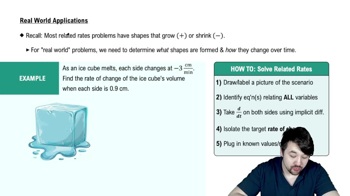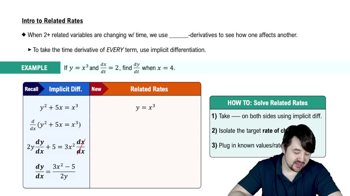Table of contents
- 0. Functions7h 52m
- Introduction to Functions16m
- Piecewise Functions10m
- Properties of Functions9m
- Common Functions1h 8m
- Transformations5m
- Combining Functions27m
- Exponent rules32m
- Exponential Functions28m
- Logarithmic Functions24m
- Properties of Logarithms34m
- Exponential & Logarithmic Equations35m
- Introduction to Trigonometric Functions38m
- Graphs of Trigonometric Functions44m
- Trigonometric Identities47m
- Inverse Trigonometric Functions48m
- 1. Limits and Continuity2h 2m
- 2. Intro to Derivatives1h 33m
- 3. Techniques of Differentiation3h 18m
- 4. Applications of Derivatives2h 38m
- 5. Graphical Applications of Derivatives6h 2m
- 6. Derivatives of Inverse, Exponential, & Logarithmic Functions2h 37m
- 7. Antiderivatives & Indefinite Integrals1h 26m
- 8. Definite Integrals3h 25m
4. Applications of Derivatives
Related Rates
Problem 3a
Textbook Question
If two opposite sides of a rectangle increase in length, how must the other two opposite sides change if the area of the rectangle is to remain constant?
 Verified step by step guidance
Verified step by step guidance1
Let the original lengths of the rectangle be represented as 'l' for length and 'w' for width, so the area A is given by A = l * w.
If the lengths of the two opposite sides (lengths) increase by a certain factor, say 'k', then the new length becomes 'l' * k.
To keep the area constant, set the new area equal to the original area: A = (l * k) * w_new, where w_new is the new width.
Since the area must remain constant, we can set up the equation: l * w = (l * k) * w_new and solve for w_new.
Rearranging the equation gives us w_new = (l * w) / (l * k), which simplifies to w_new = w / k, indicating how the width must change.
Recommended similar problem, with video answer:
 Verified Solution
Verified SolutionThis video solution was recommended by our tutors as helpful for the problem above
Video duration:
3mPlay a video:
Was this helpful?
Related Videos
Related Practice






